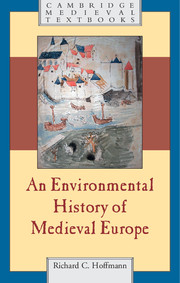Book contents
- Frontmatter
- Contents
- List of figures
- List of maps
- Preface
- Frontispiece: Nature and culture at Waterford, Ireland, 1372
- Introduction: Thinking about medieval Europeans in their natural world
- 1 Long no wilderness
- 2 Intersecting instabilities: culture and nature at medieval beginnings, c.400–900
- 3 Humankind and God’s Creation in medieval minds
- 4 Medieval land use and the formation of traditional European landscapes
- 5 Medieval use, management, and sustainability of local ecosystems, 1: primary biological production sectors
- 6 Medieval Use, management, and sustainability of local ecosystems, 2: interactions with the non-living environment
- 7 ‘This belongs to me . . .’
- 8 Suffering the uncomprehended: disease as a natural agent
- 9 An inconstant planet, seen and unseen, under foot and overhead
- 10 A slow end of medieval environmental relations
- Afterword
- A sampler for further reading
- Index
- References
9 - An inconstant planet, seen and unseen, under foot and overhead
Published online by Cambridge University Press: 05 July 2014
- Frontmatter
- Contents
- List of figures
- List of maps
- Preface
- Frontispiece: Nature and culture at Waterford, Ireland, 1372
- Introduction: Thinking about medieval Europeans in their natural world
- 1 Long no wilderness
- 2 Intersecting instabilities: culture and nature at medieval beginnings, c.400–900
- 3 Humankind and God’s Creation in medieval minds
- 4 Medieval land use and the formation of traditional European landscapes
- 5 Medieval use, management, and sustainability of local ecosystems, 1: primary biological production sectors
- 6 Medieval Use, management, and sustainability of local ecosystems, 2: interactions with the non-living environment
- 7 ‘This belongs to me . . .’
- 8 Suffering the uncomprehended: disease as a natural agent
- 9 An inconstant planet, seen and unseen, under foot and overhead
- 10 A slow end of medieval environmental relations
- Afterword
- A sampler for further reading
- Index
- References
Summary
‘In the year of the Incarnation of the Lord 849,’ wrote the learned abbot of Reichenau, Walahfrid Strabo, ‘a most great movement of the earth took place (terrae motus maximus factus est) after the first cockcrow, on April 20, a Saturday, and lasted several days. Afterwards others came intermittently until the first of June of the same year, early in the morning.’ Other sources corroborate what is thought to be Walahfrid’s personal experience of an earthquake and aftershocks centred in the Swabian Alps to the east of his cloistered island in the Bodensee. While by no means the first such event reported in the Middle Ages, Walahfrid’s rare personal witness conveys both the precise observation and meagre social context all too common in surviving records of the restless planet vexing its medieval inhabitants with seismic, volcanic, and atmospheric catastrophes.
More forthcoming were chroniclers of the harsh northern Italian winter of 1215–16, when the Po froze over in January so people could walk, joust, and drive loaded wagons upon it. One contemporary said, ‘It was so cold that bread, apples and pears, and all manner of food froze solid and could not be cut or eaten until they had been warmed up and thawed out at a fire.’ Another alleged needing an axe to hack lumps from frozen wine. These and other writers concurred that deep snow and terrible cold lasting two months caused the vines to wither and were accompanied by high cereal prices. Of course, some such tales may serve mainly dramatic purposes, but certain palaeoscientific records can test and verify seasonal weather as well as longer, less immediately perceptible trends of climate.
- Type
- Chapter
- Information
- An Environmental History of Medieval Europe , pp. 304 - 341Publisher: Cambridge University PressPrint publication year: 2014



